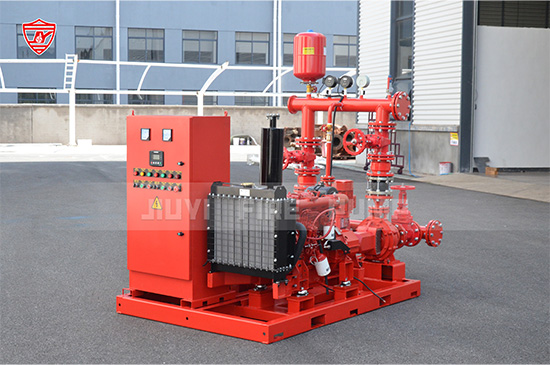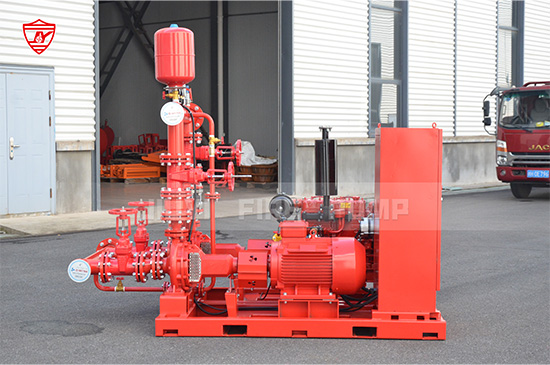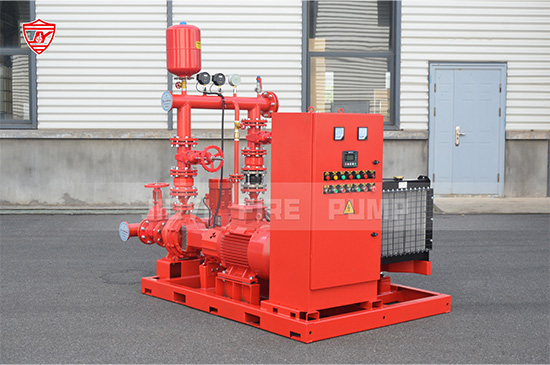Fire pumps are the heart of a building’s fire protection system. They ensure reliable water supply during emergencies, and their performance is directly tied to proper operating conditions. Among these, temperature is one of the most critical factors. If a fire pump—or the room that houses it—is too hot or too cold, performance, reliability, and compliance with standards may be compromised.
So, what temperature should a fire pump be? Let’s dive into the requirements, best practices, and technical considerations that every fire safety professional should know.

Fire pumps—whether electric motor-driven or diesel engine-driven—are mechanical systems that rely on specific environmental conditions. Temperature affects:
Pump Performance – High temperatures can cause overheating, motor damage, and reduced efficiency. Low temperatures can lead to freezing of pipes and impaired water delivery.
Compliance with Standards – NFPA 20, the standard for fire pump installations, specifies room conditions to ensure pumps are always ready.
Reliability During Emergencies – Fire pumps may sit idle for months but must start instantly in an emergency. Improper temperature control can cause failure exactly when they are needed most.
Maintenance Costs – Pumps exposed to extreme temperature swings may experience premature wear, requiring costly repairs or replacements.
The National Fire Protection Association (NFPA 20: Standard for the Installation of Stationary Pumps for Fire Protection) provides clear guidance on environmental conditions for fire pumps.
Minimum Temperature:
The fire pump room must be kept at not less than 40°F (4.4°C) to prevent water from freezing.
In cold climates, heating equipment or insulation must be used to maintain this threshold.
Maximum Temperature:
For diesel engine fire pumps, the ambient temperature must not exceed the manufacturer’s rated operating temperature, typically around 120°F (49°C).
Excessive heat can cause engine derating, oil breakdown, and reduced reliability.
For electric fire pumps, motor insulation and performance may also degrade if room temperatures rise too high.
Ventilation:
Adequate ventilation or mechanical cooling is required to keep the room within acceptable limits, especially when diesel engines generate significant heat.
While NFPA sets minimum standards, practical experience suggests a narrower, more controlled range for optimal performance:
Fire Pump Room Temperature Range: 50°F–90°F (10°C–32°C).
Diesel Engine Fire Pumps: Should ideally operate below 100°F (37°C).
Electric Fire Pumps: Perform best in a well-ventilated room below 95°F (35°C).
This controlled environment ensures:
No risk of freezing in cold climates.
Minimal overheating risk in hot climates.
Maximum service life of engines, motors, and controllers.
Diesel-driven fire pumps are more sensitive to temperature changes than electric ones. Key considerations include:
High Ambient Temperatures
Cause fuel system vapor lock.
Reduce air density, impacting combustion efficiency.
Increase radiator and cooling system demand.
Low Ambient Temperatures
Can make starting difficult due to thickened lubricating oil.
May require engine block heaters to ensure reliable cold starts.
Cooling System Requirements
NFPA 20 requires that diesel pumps be equipped with radiators or heat exchangers, and sufficient airflow must be provided to maintain safe operating temperature.
Electric motor-driven pumps are more tolerant, but temperature still matters:
Overheating can reduce motor insulation life, leading to premature failure.
Room ventilation is critical, especially when the motor operates under heavy load.
Controller electronics (such as soft starters or variable frequency drives, if permitted) may also require temperature-controlled environments.

To ensure pumps remain in optimal condition, building owners, facility managers, and fire safety engineers should implement the following:
Install reliable heating systems to prevent freezing.
Use ventilation fans or air conditioning where ambient heat may exceed safe limits.
Seal the pump room from external weather while ensuring airflow for combustion and cooling.
Install thermometers or digital sensors in the pump room.
Connect sensors to building management systems (BMS) or fire pump controllers for real-time alerts.
Required in cold climates.
Keeps coolant at recommended temperature (around 100°F/38°C), ensuring quick startup.
Prevents freezing in unheated areas.
Heat tracing may be used where insulation alone is insufficient.
Always check the fire pump engine or motor manual for specific operating limits.
Some manufacturers may have stricter requirements than NFPA.
Frozen Piping – Inadequate heating leads to cracked pipes and inability to deliver water.
Engine Overheating – Poor ventilation in diesel pump rooms can cause automatic shutdowns.
Electrical Failures – High room temperatures degrade insulation and shorten the life of controllers.
Non-Compliance with NFPA 20 – Insurance claims may be affected if systems are found out of compliance after an incident.
In a manufacturing facility in a hot climate, a diesel fire pump was installed in a poorly ventilated room. During a fire, the pump started but overheated within minutes and shut down automatically. The root cause was traced to ambient temperatures exceeding 115°F (46°C), combined with inadequate airflow for the radiator. This failure highlighted the critical importance of designing fire pump rooms with proper thermal management.
When designing new installations, engineers should:
Place the fire pump room in a central, insulated area of the building.
Avoid exposure to direct sunlight or outdoor temperature extremes.
Install redundant heating and cooling systems for critical facilities.
Design ventilation for twice the airflow required by the diesel engine radiator, as recommended in NFPA 20 Annex material.
Fire pump rooms must be maintained above 40°F (4.4°C) at all times.
Ideal operating range is 50°F–90°F (10°C–32°C) for reliable performance.
Diesel engine fire pumps are more temperature-sensitive and require heaters in cold climates and ventilation in hot ones.
Electric pumps also need proper cooling to protect motors and controllers.
Compliance with NFPA 20 and manufacturer guidelines ensures pumps are always ready when needed.

Temperature control is not just a comfort factor for fire pump rooms—it is a life-safety requirement. By maintaining an environment that protects against freezing, overheating, and system stress, building owners and safety professionals can ensure fire pumps perform flawlessly in emergencies.
At Better Technology Group, we design and manufacture fire pumps with global compliance in mind, ensuring that every system operates reliably under the required temperature ranges. Whether electric, diesel, or vertical turbine fire pumps, we provide solutions that keep facilities protected—whatever the climate.